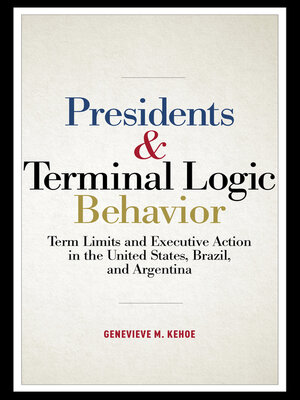Presidents and Terminal Logic Behavior
ebook ∣ Term Limits and Executive Action in the United States, Brazil, and Argentina · Joseph V. Hughes Jr. and Holly O. Hughes Series on the Presidency and Leadership
By Genevieve M. Kehoe

Sign up to save your library
With an OverDrive account, you can save your favorite libraries for at-a-glance information about availability. Find out more about OverDrive accounts.
Find this title in Libby, the library reading app by OverDrive.



Search for a digital library with this title
Title found at these libraries:
| Library Name | Distance |
|---|---|
| Loading... |
Presidents of nations with constitutionally imposed term limits are often viewed as growing weaker as they approach the end of their time in office. However, in this important new study, political scientist Genevieve M. Kehoe argues that because such chief executives are free from reelection constraint and often still enthusiastic to create a legacy by pursuing bold projects, they may accomplish significant initiatives. Kehoe has developed a concept for this which she calls "Terminal Logic Behavior" (TLB).
Presidents and Terminal Logic Behavior: Term Limits and Executive Action in the United States, Brazil, and Argentina provides both case studies and quantitative evidence to show how US presidents of the last three decades have utilized decrees on foreign, domestic, and environment policy during their final months in office. She finds a systematic pattern of decree use consistent with the mark of TLB in a most unexpected place—presidents' use of national emergency powers. In a careful comparative analysis, she also finds support for her argument in the Argentinean and Brazilian experience of the same period.
Presidents and Terminal Logic Behavior: Term Limits and Executive Action in the United States, Brazil, and Argentina provides both case studies and quantitative evidence to show how US presidents of the last three decades have utilized decrees on foreign, domestic, and environment policy during their final months in office. She finds a systematic pattern of decree use consistent with the mark of TLB in a most unexpected place—presidents' use of national emergency powers. In a careful comparative analysis, she also finds support for her argument in the Argentinean and Brazilian experience of the same period.







